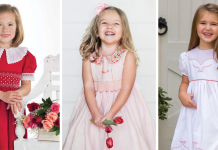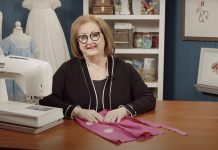
March is National Craft Month! To celebrate, we’ll be featuring a few of our favorite projects from past issues of Classic Sewing magazine right here on our blog. The projects we’ve selected to feature include both garments and home decor projects, and range from embroidery projects to items you’ll make with your sewing machine and serger. All the projects are perfect for springtime sewing. We’ll also spotlight some of our products, clubs, and online classes offered on our sister site, The Sewing Collection. We hope you enjoy!
CHARMING CARNATION SKIRT PROJECT TUTORIAL
by Evy Hawkins, originally featured in our Spring 2020 issue
Swish and twirl, pivot and whirl! This sumptuous swirly skirt conceals layers of ruffles nestled together like plush petals of a carnation! Little girls and big girls alike will adore this flouncy skirt that is perfect for spinning—and is sure to keep them grinning!
 SUPPLIES
SUPPLIES
- Quilt-weight cotton fabrics for the skirt—approximately 38 to 40* strips of fabric cut on the straight grain; each strip should be either 2.5″ wide (Jelly Roll width) or 3″ wide and as long as the width of the fabric.
- 1.5″ to 2″ wide elastic (farmhousefabrics.com)
- Serger thread and sewing thread to blend with fabrics
- Serger with Ruffling (Gathering) Foot
- Narrow Hem Foot for sewing machine (optional)
*A skirt to fit a tall three- to four-year-old may be constructed with the following apportionment of strips:
Row 1 — 1 strip
Row 2 — 2 strips
Row 3 — 3 strips plus about 12″
Row 4 — 6 strips minus about 10″
Row 5 — 10 strips minus about 6″
Row 6 — 15 strips plus about 22″
You may need to add more rows for a taller child or lessen the number of rows for a shorter child. You may also need to adjust the number of strips in each row; keep in mind that your stitch length and how much tension you put on the ruffle fabric as it feeds into the foot will affect the tightness of the ruffles. Use the recommended settings that come with your Ruffling Foot, but feel free to adjust the stitch length to your preference. (I used a stitch length of 3.) Although 38 to 40 strips of fabric might seem excessive, the ruffles of our sample skirts fold inward to resemble the petals of a carnation – and to allow for maximum twirling capacity!
 HELPFUL HINT ABOUT THE SERGER RUFFLING FOOT
HELPFUL HINT ABOUT THE SERGER RUFFLING FOOT
This foot has a flat piece of metal on the bottom that “springs” and creates tension on the fabric. If this metal piece is flat against the bottom of the foot or just barely meeting it, it will not create nice, full ruffles. As the metal spring can tend to flatten itself against the bottom of the foot with use, check to make sure it actually has room to spring. You can gently pull it away from the foot a little if necessary. Just be careful not to pull too far.
DESIGNER TIPS
These instructions are intended for use with quilt-weight cotton fabrics. Selecting a different type of fabric will change the amount of fabric required for the skirt. Heavier weight fabrics do not ruffle as tightly, so less fabric may be needed. Lighter weight fabrics ruffle very easily, so more fabric may be needed.
For a 2:1 ratio ruffle, you would normally need to double the number of strips for each consecutive lower row; however, I discovered that it took less fabric than that. It may be the way I was holding the fabric, but I think it had something to do with the weight of all the fabric as the skirt grew. You may want to have extra strips prepared, just in case you need them. —Evy
INSTRUCTIONS
1. Organize your fabric strips according to how many you will need for each row of the skirt; refer to the information above. Row 1 will be at the waist of the skirt.
2. Working on each row separately, serge strips together—short end to short end—to create one long strip for each row. (As there is only a single strip in Row 1, begin with Row 2.) A four-thread overlock with a short stitch length works nicely for this step. When finished, you should have the same number of fabric strips as you plan to have rows in the skirt.
3. Serge first row (the single fabric strip) along one long edge (Photo 1). Narrow hem or narrow roll hem the last row (the longest joined fabric strip) along one long edge, or hem otherwise as desired (Photo 2).
4. Arrange the fabric strip rows in order on your table (Photo 3).
 5. Attach the Ruffling Foot to your serger and follow the directions in the package with the foot to correctly set up the machine for ruffling.
5. Attach the Ruffling Foot to your serger and follow the directions in the package with the foot to correctly set up the machine for ruffling.
6. The Ruffling Foot works by serging two strips together while gathering the one beneath the foot. Follow these steps to attach and ruffle the rows of fabric strips:
a. Begin by placing the Row 2 strip RIGHT SIDE UP under the foot. You may find it helpful to raise the foot, gently tug up the toe of the foot and push the fabric beneath it. Next, insert the Row 1 strip WRONG SIDE UP into the slot on top of the Ruffling Foot; the finished, serged edge should be on the left (Photo 4).
b. Crank the fly wheel to take a few stitches to secure the two strips together before you begin ruffling. As you ruffle, take care not to hold back on the fabric—especially the fabric under the foot. Try not to cut off more than a whisker as you serge.
c. Add the Row 3 strip. Remember that this one will be RIGHT SIDE UP under the foot with Row 2’s ruffle WRONG SIDE UP in the slot on top of the ruffling foot (Photo 5).
d. At your sewing machine, straight stitch along the top of each row of serging to firmly secure the ruffles (Photo 6). You can either do this step as you go or wait until all of the rows are attached.
e. Repeat process, row by row, until you are finished. Remember that each subsequent row/strip is placed RIGHT SIDE UP under the foot, with the previous row/strip WRONG SIDE UP in slot on top. NOTE: The final row will be the strip with the narrow hemmed edge; make sure this strip is placed under the foot with the narrow hemmed edge on the left.
7. When finished attaching/ruffling the fabric strip rows, and after straight stitching along the top of each row of serging to secure the ruffles, inspect the fabric rows at each short end. If any of the rows do not end up flush with the row above or below, trim them off evenly. Don’t worry—your skirt will still be plenty full!
8. Measure around your child’s waist and subtract one inch. Cut a piece of 1.5″ or 2″ wide elastic to match this length.
9. Mark the top edge of the skirt to divide it into 8–10 equal parts. Then divide the elastic into the same amount of equal parts. Pin the elastic to the skirt, right sides together, so that the skirt is distributed evenly on the elastic according to the marked divisions (Photo 7).
 10. Sew elastic to skirt using a very, very narrow zigzag stitch, gently stretching the elastic as you sew from marked point to point to fit the two together neatly. You can also use a straight stitch, but the narrow zigzag allows for more stretch in the seam.
10. Sew elastic to skirt using a very, very narrow zigzag stitch, gently stretching the elastic as you sew from marked point to point to fit the two together neatly. You can also use a straight stitch, but the narrow zigzag allows for more stretch in the seam.
11. Align the ends of the elastic and each row of ruffles down to the hem. Pin right sides together and serge the skirt back seam (a four-thread overlock works well). At your sewing machine, sew along the serging to further secure the seam. Fold the seam allowance of the elastic over to one side, neatly tucking the serger tail beneath it, and topstitch in place to secure. Do the same for the seam allowance at the hem.
Now let your lucky little girl twirl to her heart’s content!
ABOUT THE DESIGNER
Evy Hawkins delights in creating original and unusual designs, projects, patterns and tutorials for the wonderful world of stitching. She currently travels and teaches at sewing events throughout the USA and also online. Visit her website to see what’s happening in her studio today.
 ENJOYED THIS PROJECT? WE THINK YOU’LL ALSO LOVE:
ENJOYED THIS PROJECT? WE THINK YOU’LL ALSO LOVE:
Classic Sewing magazine: Published four times a year, each issue features beautiful patterns for making children’s garments, casual pieces, gifts, and projects galore — all created by the industry’s best designers and leading sewing celebrities.
The Sewing Collection Online Shop: If you’re looking for the best sewing notions, supplies, and digital patterns, look no further than our Sewing Collection Online Shop! Our curated collection of sewing notions includes the tried-and-true tools that our staff uses over and over again in our own sewing rooms. Plus, you can shop machine embroidery collections, ready-to-embroider baby items, e-patterns, and more.
The Embroidery Club: This is the premier online club for sewists who love machine embroidery! Members receive access to multiple design collections, including alphabets, seasonal designs, children’s motifs, and more.
 The Doll Club: Featuring exclusive patterns designed by Connie Palmer, this online club offers members downloadable patterns for creating an adorable wardrobe of clothes and accessories designed to fit popular 18″ dolls.
The Doll Club: Featuring exclusive patterns designed by Connie Palmer, this online club offers members downloadable patterns for creating an adorable wardrobe of clothes and accessories designed to fit popular 18″ dolls.
Online Classes: We offer 100+ online sewing classes and workshops! In addition to a wide catalog of start-anytime courses, experience the fun and business opportunity of a Martha Pullen Online Licensing. Each licensing curriculum includes 30+ projects, taught by Licensing Staff along with other sewing educators.
Original Sewing & Quilt Expo: Join us live and in-person at any of our Original Sewing & Quilt Expo events held across the country. These fun and inspiring events include three days of classes, shopping, presentations, and galleries! The Expo also offers a great selection of live online sewing and quilting classes via Zoom throughout the year.
Our YouTube Channel: Visit our new YouTube channel for endless hours of sewing inspiration. You can view classic episodes of the long-running PBS show, “Martha’s Sewing Room.” More video content will be added in the future, so subscribe and stay tuned!
Plus, sign up for our newsletter to get weekly inspiration delivered right to your inbox!




